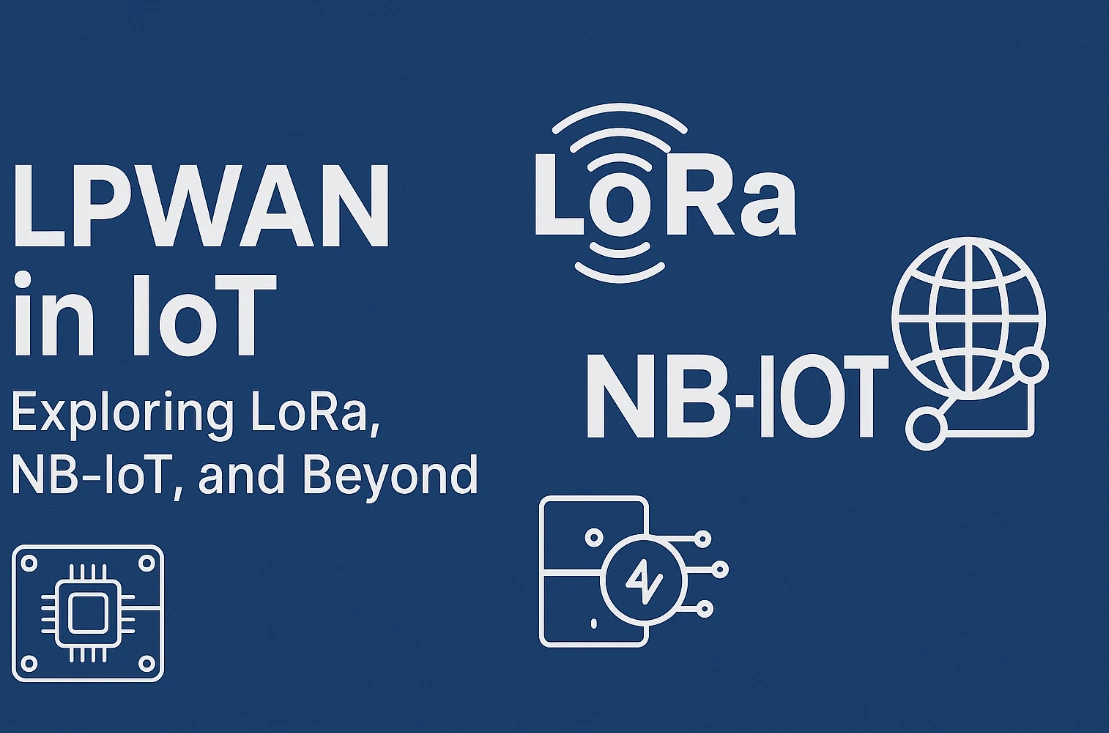LPWAN in IoT: Exploring LoRa, NB-IoT, and the Future of Long-Range Communication
A comprehensive exploration of low-power wide-area network technologies revolutionizing IoT deployments, from smart agriculture to industrial automation.
LPWAN in IoT: Exploring LoRa, NB-IoT, and the Future of Long-Range Communication

The Internet of Things (IoT) landscape is experiencing a significant transformation in terms of connectivity range and efficiency. Low-Power Wide-Area Network (LPWAN) technologies are at the forefront of this revolution, enabling long-range, energy-efficient communication for embedded devices. This comprehensive guide explores the key LPWAN technologies, their applications, and their role in shaping the future of IoT connectivity.
Understanding LPWAN Technologies
LPWAN represents a class of wireless communication technologies specifically designed for IoT applications that require:
- Long-range communication (up to 15-40 km)
- Minimal power consumption
- Cost-effective deployment
- Reliable data transmission
These characteristics make LPWAN ideal for various applications:
- Smart agriculture and precision farming
- Asset tracking and logistics
- Industrial IoT monitoring
- Environmental and remote sensing
- Smart city infrastructure
LoRa Technology: The Open Standard Leader
LoRa (Long Range) has emerged as one of the most widely adopted LPWAN protocols, offering a compelling combination of range, power efficiency, and flexibility.
Technical Specifications
- Modulation: Chirp Spread Spectrum (CSS)
- Frequency Bands:
- 868 MHz (Europe)
- 915 MHz (North America)
- 433 MHz (Asia)
- Range: Up to 15 km in optimal conditions
- Power Consumption: Ultra-low, enabling 10+ years of battery life
- Data Rate: 0.3-50 kbps
Development Ecosystem
The LoRa ecosystem is supported by:
- LoRa Alliance - Industry association
- Semtech - Primary chip manufacturer
- The Things Network - Global community network
Popular Hardware Options
- HopeRF RFM95 - Cost-effective module
- Semtech SX1276 - Industry standard
- TTGO LoRa32 - ESP32-based development board
NB-IoT: Cellular-Based LPWAN Solution
Narrowband IoT (NB-IoT) represents the cellular industry's response to the growing demand for IoT connectivity, offering several distinct advantages:
Key Features
- Licensed spectrum operation
- Deep indoor penetration
- High network reliability
- Global roaming capabilities
- Secure communication
Technical Advantages
- Spectrum Efficiency: Optimized for small data packets
- Power Management: Extended battery life through power-saving modes
- Network Integration: Seamless integration with existing cellular infrastructure
- Quality of Service: Guaranteed connectivity and data delivery
Comparative Analysis of LPWAN Technologies
| Technology | Range | Battery Life | Spectrum | Best Use Cases |
|---|---|---|---|---|
| LoRa | 2-15 km | 5-10 years | Unlicensed | Rural deployments, DIY projects |
| NB-IoT | 1-10 km | 3-5 years | Licensed | Urban areas, industrial applications |
| Sigfox | 10-40 km | 5-10 years | Unlicensed | Minimal data transmission |
Implementation Guide: LoRa with ESP32
Hardware Setup
-
Required Components:
- ESP32 development board
- LoRa module (e.g., RFM95)
- Antenna
- Power supply
-
Development Tools:
Sample Implementation
#include <SPI.h>
#include <LoRa.h>
void setup() {
Serial.begin(9600);
while (!Serial);
if (!LoRa.begin(915E6)) {
Serial.println("LoRa init failed");
while (1);
}
}
void loop() {
// Send packet
LoRa.beginPacket();
LoRa.print("Hello, LoRa!");
LoRa.endPacket();
delay(5000);
}Future Trends in LPWAN
The LPWAN landscape is evolving rapidly, with several key trends shaping its future:
- Hybrid Solutions: Combining multiple LPWAN technologies for optimal coverage
- Edge Computing: Local data processing to reduce network load
- Security Enhancements: Advanced encryption and authentication methods
- Global Roaming: Seamless connectivity across different regions
- 5G Integration: Convergence with 5G networks for enhanced capabilities
Industry Applications
Smart Agriculture
- Soil moisture monitoring
- Weather station networks
- Livestock tracking
- Crop health monitoring
Industrial IoT
- Equipment monitoring
- Predictive maintenance
- Asset tracking
- Environmental monitoring
Smart Cities
- Parking management
- Waste management
- Street lighting control
- Air quality monitoring
Best Practices for LPWAN Deployment
-
Network Planning
- Conduct site surveys
- Consider environmental factors
- Plan for scalability
-
Power Management
- Implement sleep modes
- Optimize transmission intervals
- Use energy harvesting where possible
-
Security Considerations
- Implement end-to-end encryption
- Regular firmware updates
- Secure device provisioning
Additional Resources
For more information about LPWAN technologies and implementation guidance, visit our community forum or contact our technical team.
The RootModule Team